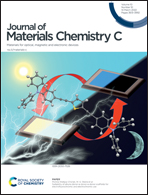Disentangling the effect of doping chemistry on the energy storage properties of barium titanate ferroelectrics using data science tools†
Abstract
Chemical modification is the most commonly used method to improve the energy storage performance of ferroelectrics. However, this strategy gives rise to rather complex compositional formulae owing to multiple elements can be used as dopants, discouraging the use of traditional methods including experiment and theory-based calculations for revealing the effect of dopants on the energy density. We herein employ data science tools, especially machine learning, to disentangle the influence of doping chemistries on the energy density. To make the analysis statistically meaningful, we focus our attention on the crossover region where the compositions possess optimized energy density as a result of singular ferroelectric domain structures. The crossover region with ∼0.7 million compositions is distinguished using a classification model separating the ferroelectric from the relaxor. The energy density for each composition is predicted by a regression model and the distribution of dopants in the compositions is comprehensively examined. The result suggests that the interaction or coupling encoded in Ca and Sn benefits the energy density, agreeing well with the analysis from two interpretable machine learning algorithms. In addition, doping elements with confined content are determined from an initial large range for future candidate design. Our work can shed light on the investigation of doping chemistries on the targeted properties in complicated materials systems.



 Please wait while we load your content...
Please wait while we load your content...